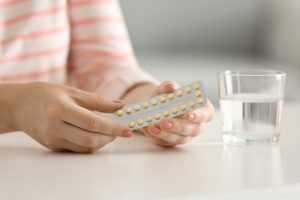Endometriosis affects roughly 10% (about 190 million) of women and girls at reproductive age worldwide. So why is this condition talked about so little? Here’s what you need to know about endometriosis and how an endometriosis specialist can help.
What is Endometriosis?
Endometriosis is an often painful disorder in which tissue grows outside your uterus. This tissue is similar to the tissue that usually lines the inside of your uterus—the endometrium, but it’s not actually your endometrium. Endometriosis most commonly involves your ovaries, fallopian tubes, and the tissue lining your pelvis. Rarely endometrial-like tissue may be found beyond the pelvic organs’ area.
With endometriosis, the endometrial-like tissue acts as your real endometrium would, so it thickens, breaks down, and bleeds with each menstrual cycle. However, the tissue cannot exit your body, so it becomes trapped. When endometriosis involves the ovaries, cysts called endometriomas may form. Surrounding tissue can become irritated, eventually developing scar tissue and adhesions — bands of fibrous tissue that can cause pelvic tissues and organs to stick to each other.
Endometriosis can be a severe condition because it can often be painful, cause irregular periods, and even lead to infertility and ovarian cancer. Here are some of the symptoms and treatments for endometriosis.
Symptoms of Endometriosis
The most common symptom of endometriosis is pelvic pain, which often happens during your menstrual period. Although painful cramping during your menstrual period is expected, those with endometriosis typically have menstrual pain far worse than usual. The pain also may increase over time the longer your endometriosis goes untreated.
Common signs and symptoms of endometriosis include:
- Painful periods (dysmenorrhea). Pelvic pain and cramping may begin before and extend several days into a menstrual period. You may also have lower back and abdominal pain.
- Pain with intercourse. Pain during or after sex is common with endometriosis.
- Pain with bowel movements or urination. You’re most likely to experience these symptoms during a menstrual period.
- Excessive bleeding. You may experience occasional heavy menstrual periods or bleeding between periods (intermenstrual bleeding).
- Infertility. Sometimes, women do not even know they have endometriosis until they realize they are struggling with infertility.
- You may also experience fatigue, diarrhea, constipation, bloating or nausea, especially during menstrual periods.
It’s important to note that the severity of your pain may not be a reliable indicator of the extent of your condition. Some women have mild endometriosis with severe pain or advanced endometriosis with little or no pain. This is why regular check-ups with your gynecologist are important so that they can monitor your reproductive system and detect any irregularities as early as possible.
Treatments for Endometriosis
One of the most beneficial steps for treating endometriosis is getting an early diagnosis. The earlier your doctor catches it, the sooner you can start treatment and prevent complications like infertility or ovarian cancer. Dr. Susan Fox is an endometriosis specialist in Miami who will be able to run the necessary tests and evaluations to determine if you have endometriosis and the best treatment for you. Endometriosis treatments include:
Pain medication
Your doctor may recommend that you take an over-the-counter pain reliever, such as the nonsteroidal anti-inflammatory drugs (NSAIDs), ibuprofen (Advil, Motrin IB, others), or naproxen sodium (Aleve) to help ease painful menstrual cramps.
Your doctor may recommend hormone therapy in combination with pain relievers if you’re not trying to get pregnant.
Hormone therapy
Supplemental hormones are sometimes effective in reducing or eliminating the pain of endometriosis. The rise and fall of hormones during the menstrual cycle causes endometrial implants to thicken, break down and bleed. Hormone medication may slow endometrial tissue growth and prevent new endometrial tissue implants.
However, hormone therapy isn’t a permanent fix for endometriosis. You could experience a return of your symptoms after stopping treatment.
Therapies used to treat endometriosis include:
- Hormonal contraceptives.
- Gonadotropin-releasing hormone (Gn-RH) agonists and antagonists.
- Progestin therapy.
- Aromatase inhibitors.
Conservative surgery
If you have endometriosis and are trying to become pregnant, your doctor may recommend surgery to remove the endometriosis implants. This is called “conservative surgery” because it aims to preserve your uterus and ovaries.
Your doctor may do this procedure laparoscopically or, less commonly, through traditional abdominal surgery in more extensive cases. Even in severe cases of endometriosis, most can be treated with laparoscopic surgery.
Fertility treatment
Because endometriosis can lead to trouble conceiving, fertility treatment may help you get pregnant. Fertility treatment ranges from stimulating your ovaries to make more eggs to in vitro fertilization. Which treatment is right for you depends on your situation.
Endometriosis Specialist in Miami | Dr. Susan Fox
Whether you are searching for a dependable endometriosis specialist in Miami or a knowledgeable practitioner to perform a pelvic reconstructive surgery, Dr. Susan Fox’s Center for Women is your most secure option.
Contact us today and book your consultation with us!






